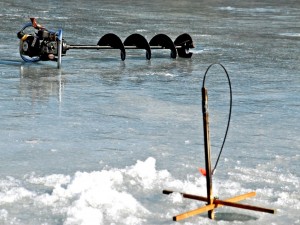
Folks who don’t ice fish think that there is nothing more to the sport than going out on the ice, drilling a hole, and catching fish. That is certainly one way to go about it, but the odds are high that you’ll be a little shy in the fish catching department. Savvy anglers use a common sense approach that begins long before the ice is thick enough to support a shanty, a vehicle, or a group of fishermen.
In many instances, scouting begins during the regular fishing season. Anglers make notes on topographical maps, on a GPS, or in their minds about certain  areas to revisit when the water is frozen. Inlets and outlets are commonly targeted areas to find fish after the ice has formed. The water moving into a pond or a lake is a good source for food, particularly after a rain. Inlets tend to spread baitfish around the general area, and it makes sense to spread out your tip ups throughout the vicinity. Outlets concentrate the baitfish as they exert a good deal of pressure as they funnel the water from the lake into a river. One point of caution is that ice in areas that near running water can be thinner than in the middle. Set up shop far enough away from the flowing water and you’ll have the best of both worlds.
areas to revisit when the water is frozen. Inlets and outlets are commonly targeted areas to find fish after the ice has formed. The water moving into a pond or a lake is a good source for food, particularly after a rain. Inlets tend to spread baitfish around the general area, and it makes sense to spread out your tip ups throughout the vicinity. Outlets concentrate the baitfish as they exert a good deal of pressure as they funnel the water from the lake into a river. One point of caution is that ice in areas that near running water can be thinner than in the middle. Set up shop far enough away from the flowing water and you’ll have the best of both worlds.
Underwater structure like rock piles, ledges, deadfall, and other formations are places where fish congregate. It’s much easier for predators to pin a baitfish against a rock than to run it down in the open, and their opportunistic feeding behavior is consistent all year long.
Fish like to run edges, and drop offs or changes in terrain are important ones to target. Lines where the shallows drop down and areas where they raise back up are excellent places to look for any kind of gamefish. Some times they’ll be on the deeper side and other times they’ll be in the skinnier water, so spread out your rods until you find where they are.
Springs are fantastic places to find fish. The constant exchange of water from the bottom always creates good fishing, and if you find one it’s usually excellent. Note the depth and place your live bait about two feet above the bottom. If you’re jigging then bounce your lure off of the bottom.
Fish finders and portable sonar devices can be helpful to see what’s underneath the ice while old school anglers (like me) rely on charts, maps and time on the water. Both ways work well, and with a few tweaks and modifications you’ll be catching instead of fishing.
This article is written by Take Me Fishing blogger Tom Keer, an award-winning freelance writer who lives on Cape Cod, Massachusetts. Visit him at www.tomkeer.com or at www.thekeergroup.com.
- 6909 views

